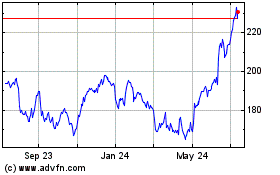By Jack Nicas in San Francisco and Josh Chin in Beijing
A tiny Chinese firm's patent victory over Apple Inc. reflects
China's efforts to better protect intellectual property that often
work against Western companies -- but sometimes benefit them.
Chinese authorities in recent years have strengthened patent
laws, offered cash rewards to patent recipients and created
specialized courts to hear intellectual-property disputes.
As a result, China surpassed the U.S. last year to become the
world's top issuer of patents, with 359,000, up 54% from 2014. U.S.
patents, meanwhile, slipped less than 1% to 298,400.
Beijing's intellectual property regulator in May ordered Apple
to stop sales of the iPhone 6 and iPhone 6 Plus in the city, ruling
that their design was too similar to a Chinese phone.
Shenzhen Baili Marketing Services Co., a shell company owned by
defunct Chinese smartphone maker Digione, won the injunction and
says it is defending its intellectual property. Apple, which is
appealing, said the ruling is stayed pending appeal, and sales are
unaffected.
Chinese courts are increasingly receptive to such patent suits,
even when they are lodged by foreign firms. Double Robotics Inc., a
Burlingame, Calif., robot maker, last month persuaded a Chinese
agency to invalidate patents claimed by a Shanghai-based rival.
Western lawyers say that as a result of China's moves, the
country is fairer to outsiders than a few years ago, but still far
from a level playing field. Patent infringement remains rampant,
and violators aren't deterred by the small damage awards there,
lawyers say. The U.S. State Department said last year that U.S.
firms saw "serious obstacles" to protecting their intellectual
property in China, including patents, copyrights, trademarks, trade
secrets and drug-test results.
"The good news is China is interested in IP, and the bad news is
China is interested in IP," said Mark Cohen, who leads the U.S.
Patent and Trademark Office's China team.
China's State Intellectual Property Office didn't respond to a
request for comment.
China had no patent law until 1985. In the three decades since,
the country has bolstered its intellectual-property laws as part of
its push to move from manufacturing to an innovation-based economy.
In the early 2000s, local governments began offering subsidies to
patent recipients, which now range as high as 30,000 yuan ($4,500).
Last year, officials proposed additional changes, including more
authority for patent officials to investigate alleged infringement
and a fivefold increase in maximum damages to 5 million yuan. The
proposal is pending.
Part of the push for better patent protection comes from
emerging giants like Huawei Technologies Co., which compete
globally and see a thick patent portfolio as crucial to selling
overseas without drawing lawsuits or paying high royalties.
More patents have led to more enforcement. Chinese officials
said they handled 35,844 patent infringement or counterfeit cases
last year, nearly four times as many as in 2012.
The vast majority of those are disputes between two Chinese
companies. But Scott Palmer, an attorney in the Beijing office of
Sheppard Mullin Richter & Hampton LLP, said foreign clients
increasingly use Chinese courts to protect their intellectual
property. He said he has five active cases with another five
expected by year's end, about double his typical rate.
Last month U.S. chip maker Qualcomm Inc. sued Chinese smartphone
maker Meizu Technology Co. in a Chinese court for using its
technology without a license. "Meizu strictly adheres to Chinese
law in China," Meizu vice president Li Nan told reporters at a
briefing.
When foreign companies sue in Chinese courts, they typically
win. From 2006 through 2014, foreign plaintiffs won about 81% of
their patent-infringement suits against Chinese companies,
virtually the same rate as domestic plaintiffs, according to data
compiled for The Wall Street Journal by the global law firm Rouse.
The firm says the numbers are incomplete, because of the difficulty
of obtaining data from Chinese courts.
One reason for the high success rate, according to several
attorneys who work in China: Most foreign firms only sue in China
if they are confident they can win.
Double Robotics, the California robot maker, hired a Chinese law
firm last year after seeing a Shanghai company selling nearly
identical versions of its $2,500 robot -- effectively an iPad on
wheels that telecommuters use to video chat with office colleagues
-- in China for less than half the price. Last month, the State
Intellectual Property Office in Beijing sided with Double Robotics
and invalidated the Chinese company's patents.
The ruling "instilled some faith in the Chinese government for
us," said Double Robotics spokeswoman Sara Broyles. "This system
that many American companies see as unfair or biased was fair for
us."
Another perk to patent litigation in China: It is cheap. Double
Robotics spent less than $30,000 on its case.
In 2009 and 2014, German chemical and pharmaceutical giant Bayer
AG won injunctions in separate cases against four Chinese firms
that used agricultural chemicals it had developed. Chinese
authorities "immediately took action" once Bayer presented evidence
of patent infringement, said Hans-Joachim Henn, a Bayer
anticounterfeit executive.
Some Chinese policies have had unintended consequences. Lawyers
say the cash payments for patents prompted some Chinese companies
to copy innovations from patents filed elsewhere.
In response, the government has made it harder to claim
subsidies. In some cases, patents now have to be granted, not just
filed, to qualify. Larger sums are offered for patents filed
abroad, where the standards are higher.
--Eva Dou contributed to this article.
Write to Jack Nicas at jack.nicas@wsj.com and Josh Chin at
josh.chin@wsj.com
Corrections & Amplifications: Double Robotics Inc. is based
in Burlingame, Calif. An earlier version of this article, and the
caption of a photo incorrectly said the company was based in Menlo
Park, Calif. (July 20, 2016)
(END) Dow Jones Newswires
July 21, 2016 02:48 ET (06:48 GMT)
Copyright (c) 2016 Dow Jones & Company, Inc.
Apple (NASDAQ:AAPL)
Historical Stock Chart
From Mar 2024 to Apr 2024

Apple (NASDAQ:AAPL)
Historical Stock Chart
From Apr 2023 to Apr 2024
